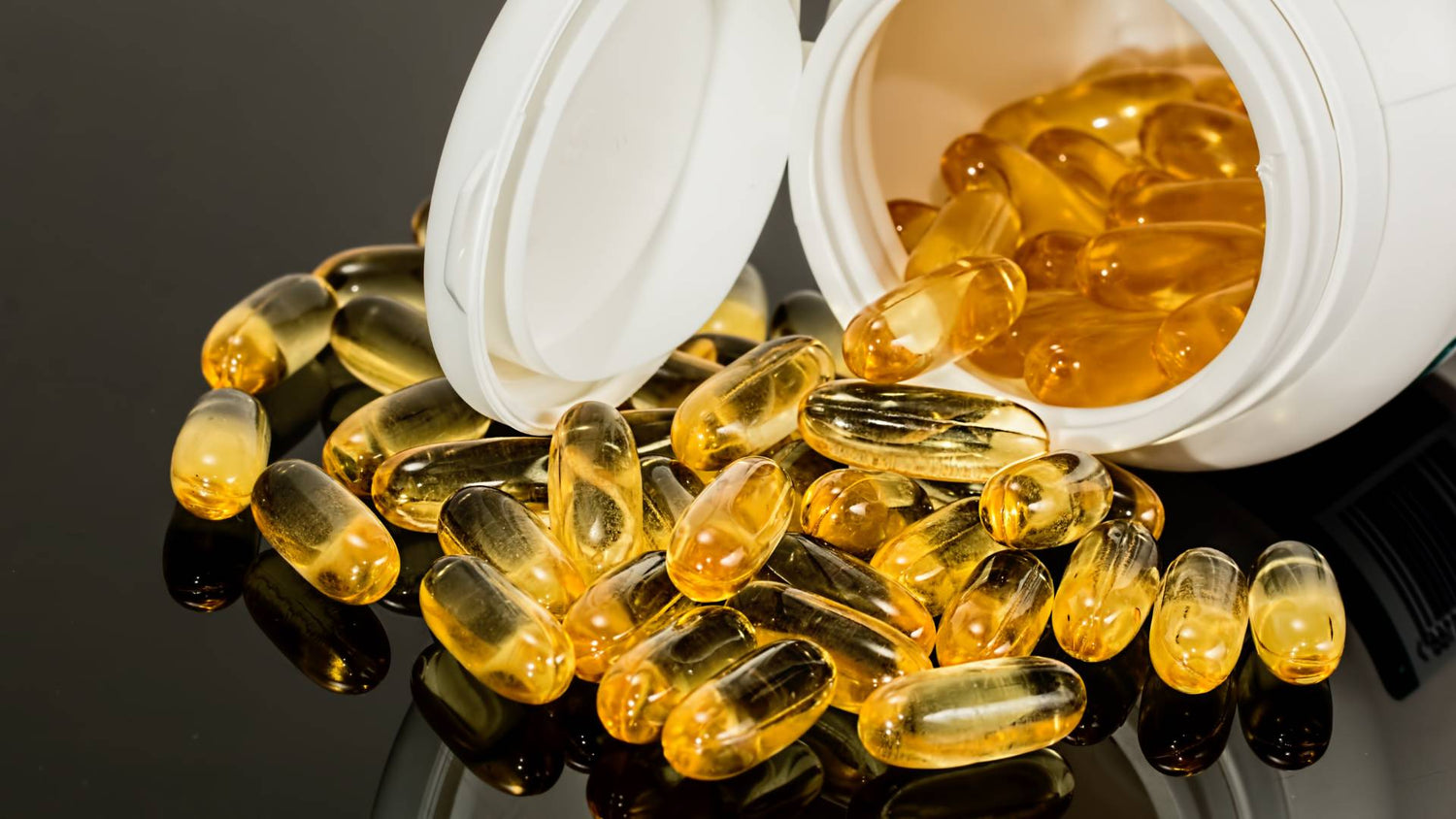Discover how omega-3 fatty acids can boost your athletic performance – including dosage tips and the best sources!
Anyone who trains regularly knows: it's not just the training itself but also recovery that determines whether you achieve your goals – whether it's muscle growth, better performance, or less muscle soreness. But did you know that the omega-3 fatty acids EPA and DHA play a crucial role in this?
While athletes often focus on their protein intake, the consumption of healthy fats, like omega-3, is frequently overlooked. Studies show that omega-3 supplementation can have a positive effect on recovery, joint health, and even performance – whether you love endurance training or prefer strength sports.
In this article, you'll discover why omega-3 is so essential for athletes, what the ideal dosage looks like, and how to incorporate the best sources – whether from fatty fish or plant-based algae – into your diet.
What Are Omega-3 Fatty Acids?
Omega-3 fatty acids belong to the group of polyunsaturated fatty acids (PUFAs) and are essential for the body, meaning it cannot produce them on its own. They must therefore be obtained through diet or supplements. For athletes, in particular, they offer valuable support for training, recovery, and muscle health.
There are three main types of omega-3 fatty acids:
-
ALA (Alpha-Linolenic Acid):
This plant-based form of omega-3 is mainly found in flaxseeds, chia seeds, and walnuts. However, ALA needs to be converted into the more active forms EPA and DHA within the body – a process that is highly inefficient. -
EPA (Eicosapentaenoic Acid):
EPA is known for its anti-inflammatory properties and plays a crucial role in post-training recovery. It helps reduce muscle soreness and supports joint health. Good sources include fatty fish like salmon, mackerel, and tuna, as well as algae oil as a plant-based alternative. -
DHA (Docosahexaenoic Acid):
DHA is particularly important for the brain, heart, and eye health. For athletes, it can boost performance by improving oxygen uptake and enhancing cardiovascular function.
Omega-3 Deficiency: An Overlooked Risk for Athletes
Many athletes focus on getting enough protein and healthy carbohydrates, but omega-3 fatty acids are often neglected. However, research shows that omega-3 intake is particularly crucial for active individuals – not just for performance, but also for recovery and joint health.
Intense training increases the body's energy demands and leads to oxidative stress, which can trigger inflammation and elevate the need for omega-3 fatty acids. If this demand isn't met, it can slow down recovery and increase the risk of injuries. Athletes who follow a plant-based diet or consume little fatty fish, such as salmon, mackerel, or tuna, are particularly prone to EPA and DHA deficiency.
According to the International Society of Sports Nutrition, many athletes suffer from omega-3 insufficiency, which can lead to the following symptoms:
-
Longer recovery times after training
-
Increased muscle soreness
-
Joint stiffness and discomfort
-
Decreased performance
-
Poor sleep quality
The Effects of Omega-3 on Your Athletic Performance
Whether you prefer endurance sports, strength training, or a combination of both, the right omega-3 intake can take your training to the next level.
Improved Endurance and Heart Function
For those who engage in regular endurance training, omega-3 can provide a significant advantage. Studies show that EPA and DHA improve oxygen uptake and enhance cardiovascular performance. This means your body can work more efficiently, positively impacting both your stamina and energy levels.
How does it work?
-
EPA has anti-inflammatory properties, promoting better blood circulation.
-
DHA supports heart health, leading to improved performance.
-
Regular intake can support muscle recovery and shorten rest periods between sessions.
If you regularly run, swim, or cycle, you’ll particularly benefit from ensuring an adequate omega-3 intake.
Increased Strength
While omega-3 alone doesn’t directly contribute to muscle growth, research indicates that it can enhance strength development when combined with resistance training. The effect depends on both dosage and duration, meaning that consistent intake of DHA and EPA over several weeks yields the best results.
What does this mean for your training?
-
Faster adaptation to heavier weights.
-
Improved muscle strength, without necessarily increasing muscle size.
-
Better recovery, enabling you to train more frequently and intensely.
No Direct Impact on Muscle Growth
A common myth is that omega-3 directly promotes muscle growth. In reality, studies show that omega-3 supplementation has no significant effect on muscle hypertrophy (increased muscle size) in young, healthy adults.
What does this mean? While omega-3 won’t make you look more muscular, it supports recovery and strength gains, helping you perform better during your workouts.
Faster Recovery and Less Muscle Soreness
Another significant benefit of omega-3 for athletes is its ability to reduce muscle soreness. After intense workouts, many report faster recovery and less muscle discomfort.
Why does this happen?
-
EPA reduces inflammation, allowing for faster muscle repair.
-
DHA promotes cell regeneration, speeding up the recovery process.
-
The benefits of omega-3 are especially noticeable with a regular intake of around 2–3 g of EPA and DHA per day.
For those who train multiple times per week, omega-3 supplementation can make a real difference—not just in terms of performance, but also in your overall well-being after training.
Omega-3 Fatty Acids for Health and Well-Being – More Than Just Sports
Omega-3 fatty acids are not only important for athletic performance but also have numerous positive effects on overall health and well-being.
-
Stronger Immune System
Omega-3 fatty acids, especially EPA, have anti-inflammatory properties that support immune cells and can reduce the risk of infections.
-
Better Sleep
Studies have shown that omega-3 fatty acids, particularly DHA, can improve sleep quality. DHA supports the production of melatonin, the hormone that regulates the sleep-wake cycle.
-
Brain Protection
A prophylactic intake of EPA and DHA can offer neuroprotective benefits. DHA protects nerve cells and improves cognitive function, while EPA reduces inflammatory processes that can occur after injuries.
-
Gut Health
Omega-3 fatty acids are now classified as prebiotic, meaning they can promote the growth of healthy gut bacteria. However, specific studies on gut health in athletes are still lacking.
Dosage: How Much EPA and DHA Do You Need?
The optimal intake of omega-3 fatty acids depends on your individual lifestyle, training routine, and dietary habits. According to the International Society of Sports Nutrition, athletes should consume 1.4 to 3 g of EPA and DHA per day to benefit from the positive effects on performance, recovery, and health.
Two Main Sources of Omega-3 Fatty Acids
-
Natural Foods:
The easiest way to meet your omega-3 needs is through the regular consumption of fatty fish. Just two servings per week can ensure adequate intake. -
100 g salmon: approx. 2.2 g omega-3 (EPA and DHA)
-
100 g mackerel: approx. 2.5 g omega-3
-
100 g tuna: approx. 1.6 g omega-3
-
High-Quality Supplements:
Not everyone enjoys or tolerates fish regularly, and for those following a vegan diet, omega-3 supplements can be a smart choice. Algae oil is the perfect plant-based alternative, providing both EPA and DHA without the need for animal sources.
Tip: When choosing omega-3 supplements, pay attention to the exact dosage. A good supplement should contain at least 500 mg of EPA and DHA per capsule.
Conclusion: Omega-3 Intake – Small Effort, Big Impact
Omega-3 fatty acids are an easy way to boost performance, accelerate recovery, and promote long-term health. Whether you're into endurance sports, strength training, or simply leading an active lifestyle, the right intake of EPA and DHA can make a real difference.
With various sources available – from fatty fish to algae oil – you can easily meet your omega-3 needs and give your body the support it needs for training, recovery, and overall well-being.
Have you already tried omega-3 supplements or regularly include omega-3-rich foods in your diet? Let us know in the comments!
Sources
[1] Jäger R, Heileson JL, Abou Sawan S, Dickerson BL, Leonard M, Kreider RB, Kerksick CM, Cornish SM, Candow DG, Cordingley DM, Forbes SC, Tinsley GM, Bongiovanni T, Cannataro R, Campbell BI, Arent SM, Stout JR, Kalman DS, Antonio J. International Society of Sports Nutrition Position Stand: Long-Chain Omega-3 Polyunsaturated Fatty Acids. J Int Soc Sports Nutr. 2025 Dec;22(1):2441775.




